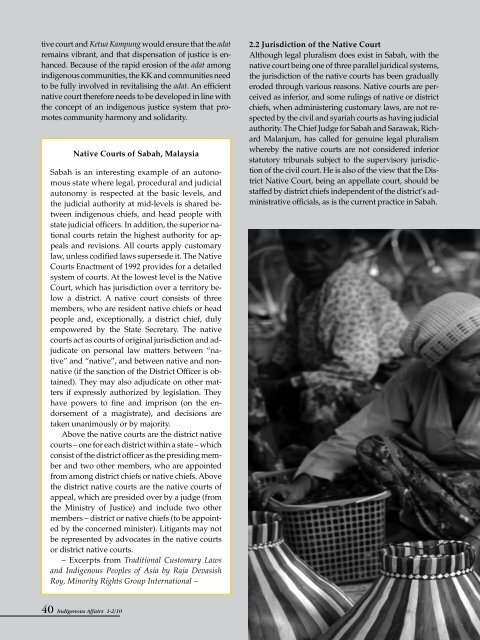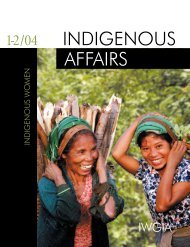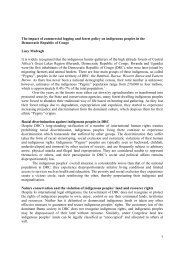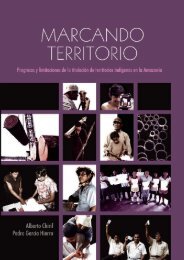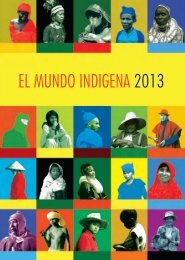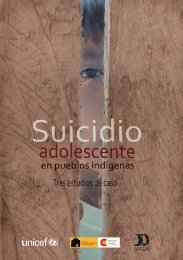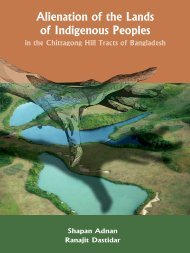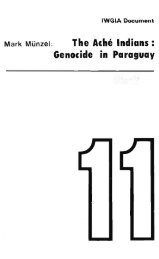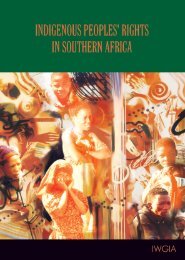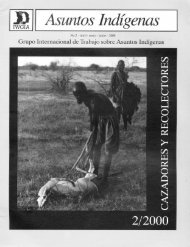Download (pdf) - iwgia
Download (pdf) - iwgia
Download (pdf) - iwgia
You also want an ePaper? Increase the reach of your titles
YUMPU automatically turns print PDFs into web optimized ePapers that Google loves.
tive court and Ketua Kampung would ensure that the adat<br />
remains vibrant, and that dispensation of justice is enhanced.<br />
Because of the rapid erosion of the adat among<br />
indigenous communities, the KK and communities need<br />
to be fully involved in revitalising the adat. An efficient<br />
native court therefore needs to be developed in line with<br />
the concept of an indigenous justice system that promotes<br />
community harmony and solidarity.<br />
Native Courts of Sabah, Malaysia<br />
Sabah is an interesting example of an autonomous<br />
state where legal, procedural and judicial<br />
autonomy is respected at the basic levels, and<br />
the judicial authority at mid-levels is shared between<br />
indigenous chiefs, and head people with<br />
state judicial officers. In addition, the superior national<br />
courts retain the highest authority for appeals<br />
and revisions. All courts apply customary<br />
law, unless codified laws supersede it. The Native<br />
Courts Enactment of 1992 provides for a detailed<br />
system of courts. At the lowest level is the Native<br />
Court, which has jurisdiction over a territory below<br />
a district. A native court consists of three<br />
members, who are resident native chiefs or head<br />
people and, exceptionally, a district chief, duly<br />
empowered by the State Secretary. The native<br />
courts act as courts of original jurisdiction and adjudicate<br />
on personal law matters between “native”<br />
and “native”, and between native and nonnative<br />
(if the sanction of the District Officer is obtained).<br />
They may also adjudicate on other matters<br />
if expressly authorized by legislation. They<br />
have powers to fine and imprison (on the endorsement<br />
of a magistrate), and decisions are<br />
taken unanimously or by majority.<br />
Above the native courts are the district native<br />
courts – one for each district within a state – which<br />
consist of the district officer as the presiding member<br />
and two other members, who are appointed<br />
from among district chiefs or native chiefs. Above<br />
the district native courts are the native courts of<br />
appeal, which are presided over by a judge (from<br />
the Ministry of Justice) and include two other<br />
members – district or native chiefs (to be appointed<br />
by the concerned minister). Litigants may not<br />
be represented by advocates in the native courts<br />
or district native courts.<br />
– Excerpts from Traditional Customary Laws<br />
and Indigenous Peoples of Asia by Raja Devasish<br />
Roy, Minority Rights Group International –<br />
2.2 Jurisdiction of the Native Court<br />
Although legal pluralism does exist in Sabah, with the<br />
native court being one of three parallel juridical systems,<br />
the jurisdiction of the native courts has been gradually<br />
eroded through various reasons. Native courts are perceived<br />
as inferior, and some rulings of native or district<br />
chiefs, when administering customary laws, are not respected<br />
by the civil and syariah courts as having judicial<br />
authority. The Chief Judge for Sabah and Sarawak, Richard<br />
Malanjum, has called for genuine legal pluralism<br />
whereby the native courts are not considered inferior<br />
statutory tribunals subject to the supervisory jurisdiction<br />
of the civil court. He is also of the view that the District<br />
Native Court, being an appellate court, should be<br />
staffed by district chiefs independent of the district’s administrative<br />
officials, as is the current practice in Sabah.<br />
40 Indigenous Affairs 1-2/10<br />
40


